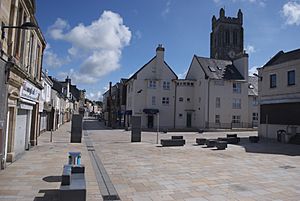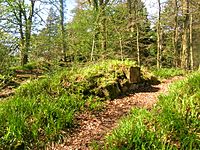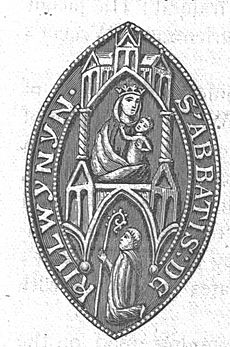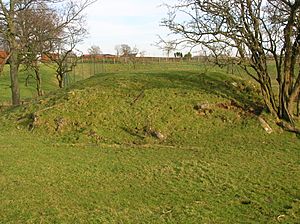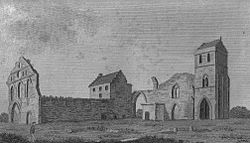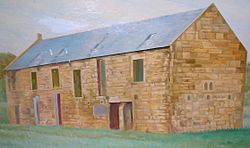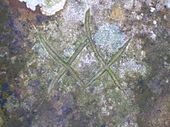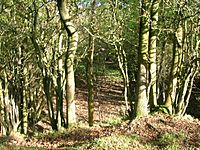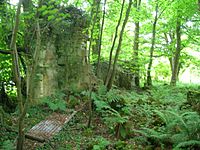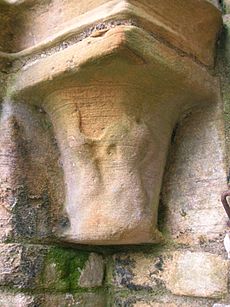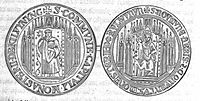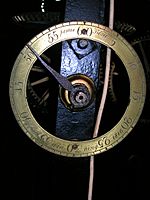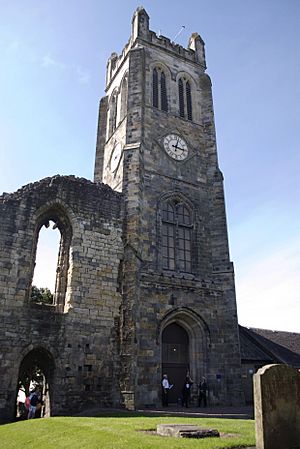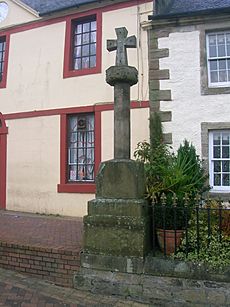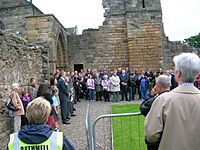Kilwinning Abbey facts for kids
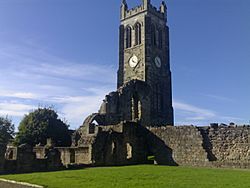 |
|
| Monastery information | |
|---|---|
| Order | Tironensian |
| Established | circa 1162 - 1168 |
| Disestablished | 1592 |
| Mother house | Kelso Abbey |
| People | |
| Founder(s) | Richard de Morville |
Kilwinning Abbey is a very old ruined building in the town of Kilwinning, North Ayrshire, Scotland. It was once a busy home for monks.
Contents
History of Kilwinning Abbey
How the Abbey Started
Kilwinning Abbey was a home for Tironensian monks. These monks followed a special set of rules from a place called Tiron in France. The abbey was built to honor Saint Winning and the Virgin Mary. It was started sometime between 1162 and 1188. Monks came from Kelso Abbey to live here.
We are not completely sure who started the abbey. It might have been Richard de Morville, who was a powerful lord in Scotland. King William of Scotland might have helped too. Sadly, many of the abbey's old records are lost. Some say they were taken away by a "furious horseman" in 1571 after an attack.
A fun old story says that Saint Winning sent his monks to fish in the River Garnock. But they couldn't catch anything! So, the saint put a curse on the river, saying no fish would ever live there. The legend says the river then changed its path to avoid the curse. We know the river has changed course a lot over time.
The area of Kilwinning on the east side of the River Garnock is still called Corsehill. This name reminds us of a cross that used to be there. It was a place for pilgrims to pray when they visited Saint Winning's shrine.
Kings also supported the abbey. King Robert II gave the abbey special rights over its lands. Later, King James IV visited the abbey in 1507. He even gave money to its holy items. The head of the abbey, called the abbot, was like a local ruler. He had the right to hold courts and make decisions for the people on the abbey's lands.
Abbey Leaders and Changes
Many abbots led Kilwinning Abbey over the years. Some famous ones include Rainer (around 1190) and William Bunsh (who died in 1513 at the Battle of Flodden). After the Reformation, new leaders called "commendators" took over. They managed the abbey's lands and money.
One important commendator was Alexander Cunninghame. Later, the lands and rights of the abbey were bought by the Earls of Eglinton.
The abbots of Kilwinning even had a special house in Glasgow.
How the Abbey Earned Money
Kilwinning Abbey was very rich! It earned money from many places. Besides churches in Kilwinning, it received money from thirteen other churches in the area. The abbey also owned large pieces of land, like at Monkcastle and Monkredding. Monkcastle was like a country home for the abbots.
The monks were also involved in farming. They had large farms called Granges, like the one at Beith. Records show they produced a lot of cheese, sometimes 268 cheeses in one year! They might have even mined coal to make sea salt.
Local stories say that Kerelaw Castle was once a palace for the abbots of Kilwinning.
The abbey's wealth made it a target. In 1512, some powerful lords tried to force the abbot to leave. In the 1860s, the abbey's income was estimated to be worth over £2 million in today's money. This money came from many different churches and lands. In the 1540s, there were seventeen monks living at the abbey.
The abbots also had a town house in Irvine.
The Abbey's Destruction
Kilwinning Abbey faced attacks even before the main destruction. In 1513, some lords robbed it. Later, in the 1540s, supporters of George Wishart caused some damage.
The biggest destruction happened around 1559. During the Scottish Protestant Reformation, led by people like John Knox, many religious buildings were attacked. It is said that statues, books, and other items were burned at Kilwinning. Ornamental tombs were broken, and stained-glass windows were smashed.
However, the abbey didn't fall into ruin just because of these attacks. Like other old religious houses, it became ruined because it no longer had enough money to keep up such large buildings. The local church only needed a small part of the abbey. Over time, wind and weather caused most of the damage.
Much of the abbey was still standing in the early 1600s. But by 1591, it was being taken apart for building materials. The stones were very useful, especially for the Montgomeries of Eglinton. Legend says one monk cursed the men who were destroying the abbey.
The last Catholic abbot, Archbishop Gavin Hamilton, died in 1571. After this, the abbey's lands and titles were eventually bought by Hugh, the 5th Earl of Eglinton, in 1603.
Another version of the Saint Winning fishing legend says the river changed course to avoid the saint's curse.
The Ardeer Legend
There's a sad story about the murder of the Earl of Eglinton's wife on Ardeer in the 1500s. The Earl didn't believe in the miracles at Kilwinning Abbey and stopped paying money to the monks. In revenge, the abbot supposedly arranged for the Countess to be captured and starved to death in a hidden cellar. The Earl never found her. Years later, the last monk of Kilwinning Abbey is said to have confessed to the crime, revealing the truth.
What Happened to the Abbey Buildings?
After the main abbey buildings were destroyed, the Earls of Eglinton used parts of the old abbey walls as a family home. Lady Mary Montgomerie lived there in the 1600s.
Many stones from the abbey were used to build Eglinton Castle and its deer park wall. The dovecot (a building for doves) at Eglinton might also have come from the abbey. The stables at Eglinton were definitely built from stones taken from the abbot's old home within the abbey.
Part of the old abbey church was used as the local parish church. In 1775, a new Abbey church was built on the same spot, also using stones from the old abbey.
Seagate Castle was built as a town house for the Earl of Eglinton between 1565 and 1582. Its entrance might have used stones from Kilwinning Abbey.
Some parts of the abbey still stand as ruins today. They are a popular place for visitors in Kilwinning. The rebuilt tower now has a museum.
Monkcastle near Dalry was the abbot's country house and is now a ruin. Monkredding House was a rest house for the monks and still exists in a changed form.
Stones from the abbey were also used in a building called 'Railway Cottage' near Benslie.
What Archaeology Tells Us
Archaeologists have learned a lot about the abbey. The main part of the church was very wide, even wider than famous churches like Paisley or Glasgow Cathedral. It was special because it had two towers at the west end that stood separately. One of these towers fell down quite early.
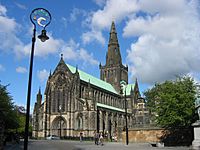
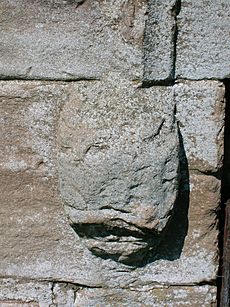
Digs suggest the abbey was built around an older church from the 1150s. A long wall might be from this earlier church. A special archway, built around 1190-1200, has unique carvings of Adam and Eve.
A big building project happened in the 1230s. The two towers and the west part of the church seem to have been added in the 1250s.
Abbey Treasure Legends
People say that the abbey's valuable items, like the Black Book, gold candlesticks, and silver cups, were never found. Legend has it they are hidden in a secret vault beneath the abbey. Another story says they were hidden on one of the small islands (called crannogs) in the nearby Ashgrove or Stevenston Loch.
Kilwinning Abbey Tower
The Earl of Eglinton used the old abbey tower as a prison. Its bells were rung to call people together for the king or in times of war.
The original tower stood until 1814. It was struck by lightning in 1809, which damaged it a lot. It became unsafe and was taken down with gunpowder.
New plans were quickly made for a replacement tower. On December 21, 1814, the first stone for the new tower was laid. The new 103-foot-high clock tower was finished on November 12, 1816.
Today, the tower is owned by North Ayrshire Council. It has a heritage center that opened in 1995. The center shows items about the abbey's history and famous local poets like Robert Burns.
The Ancient Society of Kilwinning Archers, which started in 1483, is also featured. They still meet regularly. They hold an annual "papingo" shoot in June. This is said to be the oldest archery competition in the world! Archers try to knock down a wooden bird (a 'papingo') from the clock tower.
The Heritage Centre is managed by the council but run by volunteers from Kilwinning Heritage.
Views of Kilwinning Abbey
Saint Winning
Saint Winning's Cross
An old cross, called Saint Winning's Cross, was once on the main street. It was said to have been at the first church built by Saint Winning. Miracles were believed to happen there.
A piece of this old cross is now in the North Ayrshire Heritage Centre. It has carvings of David with a harp and David on horseback. These carvings might show good winning over evil. Other parts of the cross were found during digs at the abbey in the 1960s.
Saint Winning's Well
This well was said to have formed from the saint's tears. In the 1860s, it still had pure water. But it was destroyed when the Glasgow and South Western Railway was built.
A legend says that a well blessed by the saint turned red for eight days during important times, like wars, in 1184.
Other Chapels Nearby
Before the Reformation, there might have been three or four small chapels linked to the abbey. One was near Chapelholm Wood or Benslie wood. Another was at Weirston, and one near Stanecastle gate.
Evidence for these chapels includes names like Chapelcroft farm and Chapel Bridge. The Weirston chapel might have been a private chapel for the Montgomerie family.
Masonic Connections
The abbey has a link to Freemasonry. People believe that skilled foreign masons, helped by Scottish masons, built the abbey. These foreign masons brought their traditions with them to Scotland. The main architect was said to be the master mason of Scotland.
It is said that King James I was a supporter of the Mother Lodge of Kilwinning. The Tironensian monks were known for their skills in building and stonework. Many of the early Freemasons were actually monks.
Secret Tunnels
There are stories about a two-mile-long secret tunnel from Kilwinning Abbey to Eglinton Castle. It's said to go under the River Garnock and the Lugton Water. There's no proof of this tunnel. It might be linked to the underground burial vault of the Montgomerie family or the abbey's old sewer system. Another tunnel is rumored to run from the abbey to Monkredding House.
Burials at the Abbey
Many important people were buried at Kilwinning Abbey. This includes several Earls of Eglinton and Winton. The Earls of Eglinton were buried here until 1886. Some of their burial vaults were still there until 1961.
The Abbey Doocot
A large, fancy doocot (a building for doves) is located near Eglinton. It is said to have come from the abbey. The doocot's design is from the 1500s or 1600s. The carvings on its door and the stones themselves might have come from the old abbey.
Abbey Mills
The abbey owned several mills. The Bridgend mill on the Garnock River was given to the commendator's son in 1645. Another mill was the modern-day Dalgarven Mill. The location of a third mill is not known for sure, but Sevenacres Mill is a likely spot.
A Funny Story
Robin Cummel tells a story about the old abbey where no females were allowed inside. One day, the Abbot heard crying from a dormitory. He went to check and found a mother cat with her five kittens!
See also
- Drukken Steps
- Abbot of Kilwinning, for a list of abbots and commendators
- The Lands of Montgreenan - more about the murder of Alexander Cunninghame, a commendator of the abbey.
- Lands of Willowyard
- Eglinton Country Park - more about the abbey doocot and other details.


